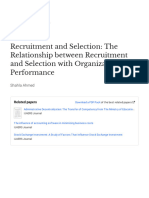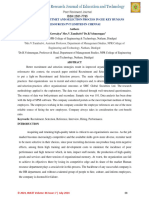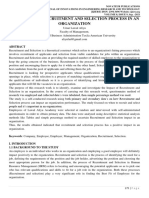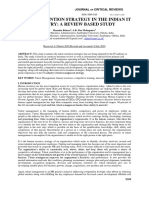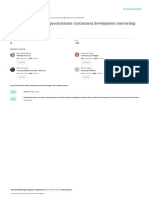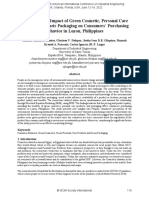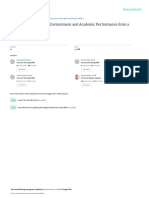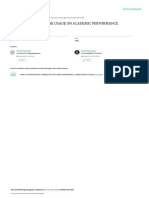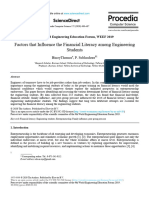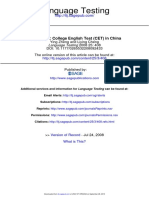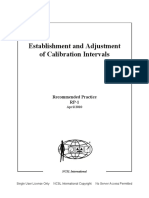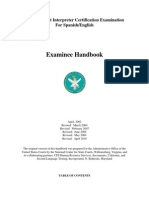12
12
Uploaded by
sharkti900Copyright:
Available Formats
12
12
Uploaded by
sharkti900Copyright
Available Formats
Share this document
Did you find this document useful?
Is this content inappropriate?
Copyright:
Available Formats
12
12
Uploaded by
sharkti900Copyright:
Available Formats
Juni Khyat ISSN: 2278-4632
(UGC Care Group I Listed Journal) Vol-10 Issue-5 No. 4 May 2020
EMPLOYEES PERCEPTION ON RECRUITMENT AND SELECTION
PRACTISES IN HOTEL INDUSTRY
Dr.K.Saravanan, Assistant Professor
Department of Business Administration
Annamalai University,Annamalainagar,Tamilnadu-608002
Abstract
One of the most significant developments in the field of organizations in recent times
is the increasing importance given to human resource. People are vital to organizations as
they offer perspectives, values and attributes to organizational life; and when managed
effectively, these human traits can be of considerable benefits to the organization. Employee
performance is vital to all business enterprises in both developed and developing countries.
The success and failure of the business enterprise depends on its human resource. Finding the
right man for the job and developing him into valuable resources is an indispensable
requirement of every organization. The selection practices may have an effect on the
employee’s perceptions; Proper recruitment helps the line managers to work most effectively
in accomplishing the primary objective of the enterprise. The main idea behind conducting
this research was to examine the relationship between the perceptions on Recruitment and
selection practices and the demographic factors among the employees of hotel industry.
Keywords: Human resource, Recruitment, Organization, Perception,
Introduction
In an environment of hastily growing aggressive challenges, every company has to
invest across the value chain to attain outstanding aggressive capability in each of the busi-
nesses in its portfolio. The dream of every organization is now apparently the formation of
exclusive business models that encourage international. The recruitment and selection
process is one of the most important aspects of running new and established businesses alike.
The right employees can take the business to new heights. The wrong ones can hurt business
by missing sales, turning customers off and creating a toxic workplace environment
competitiveness of not only its business but also the entire value chain of which it is a part.
Recruitment and Selection plays an important role where it acts as a crypt to erect
Organisation’s competence by attracting efficient and potential candidates who can fulfil the
Page | 80 www.junikhyat.com Copyright ⓒ 2020 Authors
Juni Khyat ISSN: 2278-4632
(UGC Care Group I Listed Journal) Vol-10 Issue-5 No. 4 May 2020
goals of the Organisation.. Recruitment is a process of hiring potential candidates who are
talented of filling the job position that can boost Organisation’s future expansion and grades
in healthier way.
Recruitment and selection
Recruitment and selection is one of the basic functions of Human Resource
Management and plays a pivotally important role in shaping an organisation’s effectiveness
and performance. It is often claimed that selection of employee occurs not just to replace
departing employees or add to a workforce, but rather aims to get in the employees who can
perform at a high level and demonstrate commitment (Ballantyne, 2009). Recruitment and
Selection are terms often used interchangeably and it is essential to understand them and also
deliberate on the linkage and interdependence. There is a clear distinction between
recruitment and selection. Walker, Feild, Giles, Armenakis, and Bernerth (2009) explained
that recruitment is the process of attracting a large pool of qualified people for employment.
This involves planning for human resource to job design, job description, job analysis,
creating awareness among others. Selection on the other hand is the process through which
organizations make decisions about who will or will not be allowed to join the organization.
The selection process varies from organization to organization, job to job, and country
to country. Barbar (1998) indicates that there are two important phases of the recruitment
processes that are very essential for good recruitment and selection processes. First, to attract
large numbers of applicants and the second is the ability of Human Resource Divisions to
make the best selections out of the total applicants (Barbar, 1998). Cole (2002) stated that the
principal purpose of recruitment activities is to attract sufficient and suitable potential
employees to apply for vacancies in an organisation. The principal purpose of selection
activities, by comparison, is to identify the most suitable applicants and persuade them to
accept a position in the organisation. The importance of having efficient and effective
procedures for recruitment and selection can hardly be exaggerated. Cole (2002) is of the
view that when organizations are able to find and employ qualified employees who are
consequently able to fit in their roles and are competent, the organization will be able to take
advantage of opportunities and take care of threats and competition from its operating
environments that other organizations who are constantly battling with building and
maintaining their workforce. Recruitment is the process whereby an organisation generates a
pool of qualified, skilled and knowledgeable persons applying to an organization for
employment
Page | 81 www.junikhyat.com Copyright ⓒ 2020 Authors
Juni Khyat ISSN: 2278-4632
(UGC Care Group I Listed Journal) Vol-10 Issue-5 No. 4 May 2020
Review of Literature
Aruna S,2015). According to the paper “Recruitment and Selection in Public
Organizations In Nigeria: A Case Study of university of Nigeria, Nsukka” it is described that
in order to manage resources, money, men, and work and to maintain organisation, suitably
qualified people should be recruited in both non managerial and managerial functions
Tulauan, Mayra Madria(2014) studied “Perceived effectiveness of Recruitment and
Selection process for Uniformed Personnel of the Philippine National Police” and revealed
that organisations give more preference to hard technical skills instead considering their soft
behavioural skills which helps in understanding that the employees can be quickly trained
and their potential traits. Based on the paper “The Recruitment and Selection Process of
Pharmaceutical Companies in Bangladesh: A Case on GlaxoSmithKline Bangladesh
Limited”, says that while recruiting the candidates it is necessary to identify the prospective
candidate who can contribute to fulfil the strategic aim of the organisation.
The study of Opayemi, and Oyesola (2013) established the relevance of some
personal attributes or socio-demographic factors as influencing perception of the link
between selection interview, selection test and employee performance. The study revealed
that employees in the age range of 20-25 years reported the highest mean score on perception
of the link between selection interview, selection test and employee performance. Therefore,
recruitment/selection interview and recruitment/selection test are good predictors of
employee performance, if conducted in a standardized form.
Stephen, Cowgill, Hoffman and Housman (2013) studied impact of hiring through
referral using novel and detailed productivity and survey data from nine large firms in three
industries revealed that employee referrals allow firms to select workers that better suit for
particular jobs in the organization that firms benefit from referrals predominantly by selecting
workers with a better fit for the job, as opposed to referrals selecting workers with higher
overall quality. The study shows that employee referrals enhances monitoring and coaching
and makes work environment more enjoyable as they work with friends because workers
refer others like themselves, not only in characteristics but in behavior.
Objective of the study
To analyze the employees perception on Recruitment and selection strategies in hotel
industries based on demographic factors viz, Gender, Occupation, educational qualification
and experience.
Page | 82 www.junikhyat.com Copyright ⓒ 2020 Authors
Juni Khyat ISSN: 2278-4632
(UGC Care Group I Listed Journal) Vol-10 Issue-5 No. 4 May 2020
Hypothesis
There is no significant difference between the employees perception on Recruitment
and selection strategies and demographic factors viz, Gender, Occupation, educational
qualification and experience of the respondents.
Research Methodology
This study aims at identifying the perception of employees on Recruitment and
selection in hotel industries based on demographic factors viz, Gender, Occupation,
educational qualification and experience by conducting an experimental study in the
automobile industry. In this study, the indicators relating to Recruitment and selection were
recognized under the exploratory research framework. The identified variables are cross
tabulated with the socio-economic status of the employees and thereby it gives analytical
orientation and hence this study is descriptive in nature. A disproportionate stratified
sampling technique has been adopted for this study and 200 employees were taken for this
study. With disproportionate stratification, the sample size of each stratum is equal in all
stratums. The reliability value 0.8930 was established and validity is 0.7468.
Table: 1, Reliability Co-Efficient and Test of Significance for the Questionnaire Used in
the Study
Sl. No Test of Levels of
Test N Reliability
Significance Significance
1. Perception on Recruitment
100 0.8930 3.43 0.01
and selection
Table-1 presents the data regarding the reliability co-efficient and test of significance for
the questionnaire used in the study.. The indicator of recruitment and selection has a liability
score of 0.8930 correlation co-efficient value and it is statistically significant as per the result
of ‛t’ test
Table: 2, Validity Co-Efficient and Test of Significance for the Questionnaire Used in
the Study
Validity
Test of Level of
Sl. No Test N Correlation
Significance Significance
Co-efficient
1. Perception on
100 0.7468 7.76 0.01
Recruitment and selection
Table-.2 presents data regarding the validity co-efficient and test of significance for
the questionnaire used in the study.. The indicator of recruitment and selection has a validity
Page | 83 www.junikhyat.com Copyright ⓒ 2020 Authors
Juni Khyat ISSN: 2278-4632
(UGC Care Group I Listed Journal) Vol-10 Issue-5 No. 4 May 2020
score of 0.74 correlation co-efficient value and it is statistically significant as per the result of
‛t’ test.
Results and discussion
Socio- Economic Status
Socio-Economic condition is an economic and sociological combined measure of an
employees’ professional experience and of an individual's or family’s economic and social position in
relation to others, based on educational qualification, gender and occupational status.
Table: 3 Socio–Economic Status
Gender Number of Respondents Percentage
Male 136 68
Female 64 32
Total 200 100
Occupation Number of Respondents Percentage
Office employees 33 16.5
Technicians 60 30
General workers 72 36
Casual labor 35 17.5
Total 200 100
Education Number of Respondents Percentage
Secondary 59 29.50
Higher secondary 41 20.50
Diploma 44 22
Under graduate 36 18
Post graduate 20 10
Total 200 100
Length of service Number of Respondents Percentage
Up to 5 years 38 19
5-10 years 50 25
10-15 years 34 17
15-20 years 52 26
Above 20 years 26 13
Total 200 100
Source: Computed from Primary data
Page | 84 www.junikhyat.com Copyright ⓒ 2020 Authors
Juni Khyat ISSN: 2278-4632
(UGC Care Group I Listed Journal) Vol-10 Issue-5 No. 4 May 2020
Recruitment and Selection
Null Hypothesis: There is no significant difference between the gender and
Perception on Recruitment and selection
Table: 4 Gender-wise Respondents rating of perception on Recruitment and Selection
Variables Male Female Mean
Recruits workers after positions are declared vacant 3.52 3.06 3.29
Internal and external sources of vacancy fulfillment 2.91 2.45 2.68
Recruitment policy 2.70 2.24 2.47
Publicity for existing job vacancies 2.34 2.08 2.21
The employees are involved in making decisions on employment 3.04 2.58 2.81
Transparency in the short listing of job aspirants 3.68 3.22 3.45
Involvement of heads in the screening process 2.33 1.87 2.10
Job aspirants with right skills were considered 2.59 2.13 2.36
The organization does not encourage the influence of external
3.31 2.85 3.08
forces during the selection process
The organization takes into consideration affirmative action during
2.79 2.33 2.56
the recruitment and selection procedure of staff
Organization acknowledges all application letter 3.16 2.70 2.93
Lack of political influence in selection of workers 3.84 3.38 3.61
Selection of workers based on government rules and regulations 4.12 3.86 3.99
Merits and efficiency is a yard stick in selection process 4.23 3.97 4.10
Selection of employees according to prescribed qualification 4.07 3.61 3.84
Average 3.24 2.82 3.03
Source: Computed from the Primary Data
‛t’ Statistical Value 6.86, df 14, ‛t’ Critical Value 1.76
Further the ‛t’ test is applied and computed the ‛t’ value as 6.86which is higher
than the tabulated value at 5 per cent significant level. Hence, there is a significant difference
between the genders and their perception. It can be concluded that the male workers prefers
the present recruitment and selection process in their organization than their counter part.
Since, the calculated value is higher than its tabulated value, the null hypothesis is rejected.
Null Hypothesis: There is no significant difference between level of education and
their perception on recruitment and selection.
Page | 85 www.junikhyat.com Copyright ⓒ 2020 Authors
Juni Khyat ISSN: 2278-4632
(UGC Care Group I Listed Journal) Vol-10 Issue-5 No. 4 May 2020
Table: 5 Education-wise Respondents Rating of Recruitment and Selection
Secondary
Secondary
Graduate
Graduate
Diploma
Higher
Under
Post
Variables Mean
Recruits workers after positions are declared
2.91 3.00 3.23 3.48 3.82 3.29
vacant
Internal and external sources of vacancy
2.30 2.39 2.62 2.87 3.21 2.68
fulfillment
Recruitment policy 2.09 2.18 2.41 2.66 3.00 2.47
Publicity for existing job vacancies 1.83 1.92 2.15 2.40 2.74 2.21
The employees are involved in making
2.43 2.52 2.75 3.00 3.34 2.81
decisions on employment
Transparency in the short listing of job
3.07 3.16 3.39 3.64 3.98 3.45
aspirants
Involvement of heads in the screening
1.72 1.81 2.04 2.29 2.63 2.10
process
Job aspirants with right skills were
1.98 2.07 2.30 2.55 2.89 2.36
considered
The organization does not encourage the
influence of external forces during the 2.70 2.79 3.02 3.27 3.61 3.08
selection process
The organization takes into consideration
affirmative action during the recruitment and 2.18 2.27 2.50 2.75 3.09 2.56
selection procedure of staff
Organization acknowledges all application
2.55 2.64 2.87 3.12 3.46 2.93
letter
Lack of political influence in selection of
3.23 3.32 3.55 3.80 4.14 3.61
workers
Selection of workers based on government
3.63 3.90 4.03 4.18 4.20 3.99
rules and regulations
Merits and efficiency is a yard stick in
3.82 4.11 4.14 4.19 4.23 4.10
selection process
Selection of employees according to
3.56 3.65 3.88 4.03 4.07 3.84
prescribed qualification
Average 2.67 2.78 2.99 3.22 3.49 3.03
Source: Computed from the Primary Data
Page | 86 www.junikhyat.com Copyright ⓒ 2020 Authors
Juni Khyat ISSN: 2278-4632
(UGC Care Group I Listed Journal) Vol-10 Issue-5 No. 4 May 2020
ANOVA
Source of Variation SS df MS F F crit
Variation due to
recruitment and
selection process 30.0352 14 2.145371 267.2488 1.872588
Variation due to
educational status 6.669053 4 1.667263 207.6909 2.536579
Error 0.449547 56 0.008028
Total 37.1538 74
For further analysis, the ANOVAs two ways model is applied and the computed value is
267.24 which is higher than its tabulated value at 5 percent significant level. Hence, the
variation among the indicators of recruitment and selection is statistically significant. In an
additional point, the computed ANOVA value 207.69 is higher than the tabulated value at 5
percent significant level. Since, the calculated value is higher than its tabulated value at five
per cent significant level, the null hypothesis is rejected.
. Null Hypothesis: There is no significant difference between the occupation and their
perception on recruitment and selection process.
Table: 6 Occupation-wise Respondents Rating of Recruitment and Selection
Technicians
Employees
Workers
laborers
Casual
Office
Variables Mean
Recruits workers after positions are declared vacant 3.68 3.42 3.16 2.90 3.29
Internal and external sources of vacancy fulfillment 3.07 2.81 2.55 2.29 2.68
Recruitment policy 2.86 2.60 2.34 2.08 2.47
Publicity for existing job vacancies 2.60 2.34 2.08 1.82 2.21
The employees are involved in making decisions on
3.20 2.94 2.68 2.42 2.81
employment
Transparency in the short listing of job aspirants 3.84 3.58 3.32 3.06 3.45
Involvement of heads in the screening process 2.49 2.23 1.97 1.71 2.10
Job aspirants with right skills were considered 2.75 2.49 2.23 1.97 2.36
The organization does not encourage the influence of
3.47 3.21 2.95 2.69 3.08
external forces during the selection process
The organization takes into consideration affirmative 2.95 2.69 2.43 2.17 2.56
Page | 87 www.junikhyat.com Copyright ⓒ 2020 Authors
Juni Khyat ISSN: 2278-4632
(UGC Care Group I Listed Journal) Vol-10 Issue-5 No. 4 May 2020
Technicians
Employees
Workers
laborers
Casual
Office
Variables Mean
action during the recruitment and selection procedure of
staff
Organization acknowledges all application letter 3.32 3.06 2.80 2.54 2.93
Lack of political influence in selection of workers 4.00 3.74 3.48 3.22 3.61
Selection of workers based on government rules and
4.18 4.12 3.96 3.70 3.99
regulations
Merits and efficiency is a yard stick in selection process 4.24 4.20 4.07 3.89 4.10
Selection of employees according to prescribed
4.13 4.07 3.71 3.45 3.84
qualification
Average 3.39 3.17 2.92 2.66 3.03
Source: Computed from the Primary Data
ANOVA
Source of Variation SS df MS F F crit
Variation due to
recruitment and
selection process 24.02816 14 1.716297 457.9312 1.935009
Variation due to
occupational status 4.417187 3 1.472396 392.855 2.827049
Error 0.157413 42 0.003748
Total 28.60276 59
For further analysis the ANOVAs two ways model is applied and computed the
ANOVA value as 457.93which is higher than the tabulated value at 5 percent significant
level. Hence, the variation among the indicators of recruitment and selection process is
statistically significant. In an additional point, the computed ANOVA value 392.85 is greater
than its tabulated value at 5 percent significant level. the null hypothesis is rejected.
Null Hypothesis: There is no significant difference between the experience and their
perception on recruitment and selection process.
Page | 88 www.junikhyat.com Copyright ⓒ 2020 Authors
Juni Khyat ISSN: 2278-4632
(UGC Care Group I Listed Journal) Vol-10 Issue-5 No. 4 May 2020
Table: 7, Length of Service-wise Respondents Rating of Recruitment and Selection
Up to 5 years
10-15 years
15-20 years
5-10 years
Above 20
years
Variables Mean
Recruits workers after positions are
2.68 3.05 3.18 3.66 3.88 3.29
declared vacant
Internal and external sources of vacancy
2.07 2.44 2.57 3.05 3.27 2.68
fulfillment
Recruitment policy 1.86 2.23 2.36 2.84 3.06 2.47
Made aware of existing job vacancies 1.70 1.97 2.10 2.58 2.70 2.21
The employees are involved in making
2.20 2.57 2.70 3.18 3.40 2.81
decisions on employment
Transparency in the short listing of job
2.84 3.21 3.34 3.82 4.04 3.45
aspirants
involvement of heads in the screening
1.78 1.86 1.99 2.37 2.50 2.10
process
Job aspirants with right skills were
1.85 2.12 2.25 2.73 2.85 2.36
considered
The organization does not encourage the
influence of external forces during the 2.47 2.84 2.97 3.45 3.67 3.08
selection process
The organization taken into consideration
affirmative action during the recruitment 2.05 2.32 2.45 2.93 3.05 2.56
and selection procedure of staff
Organization acknowledges all
2.32 2.69 2.82 3.30 3.52 2.93
application letter
Lack of political influence in selection of
3.00 3.37 3.50 3.98 4.20 3.61
workers
Selection of workers based on
3.48 3.93 4.08 4.16 4.20 3.99
government rules and regulations
Merits and efficiency is a yard stick in
3.75 4.06 4.14 4.20 4.24 4.10
selection process
Selection of employees according to
3.33 3.70 3.93 4.11 4.13 3.84
prescribed qualification
Average 2.49 2.82 2.96 3.36 3.51 3.03
Source: Computed from the Primary Data
Page | 89 www.junikhyat.com Copyright ⓒ 2020 Authors
Juni Khyat ISSN: 2278-4632
(UGC Care Group I Listed Journal) Vol-10 Issue-5 No. 4 May 2020
ANOVA
Source of Variation SS df MS F F crit
Variation due to
recruitment and selection
process 29.61247 14 2.115177 168.0725 1.872588
Variation due to work
experience 10.17553 4 2.543881 202.1375 2.536579
Error 0.704755 56 0.012585
Total 40.49275 74
For further analysis ANOVA two-way model is applied and computed the ANOVA
value as 168.07which is higher than the tabulated value at 5 percent significant level. Hence,
the variation among the indicators of recruitment and selection is statistically significant. In
an additional point, the computed ANOVA value 202.13 is higher than its tabulated value at
5 percent significant level. the null hypothesis is rejected.
Conclusion
Recruitment and selection has the capacity to take up a key part of the process of managing
and leading people as a routine part of organizational life. It has become more important as
organizations increasingly regard their workforce as a source of competitive advantage. There
is evidence of increased interest in the utilization of employee selection methods which are
valid, reliable and fair.. Employers are surprised and disappointed when an appointment fails,
and often the person appointed is blamed rather than recognizing the weaknesses in the
process and methodology, even the soundest of techniques and best practice (in recruitment
&selection) contain scope for error. Some of this is due to the methods themselves, but the
main source is the frailty of the human decision makers. One result of effective recruitment
and selection is reduced labour turnover and good employee morale. Recruiting ineffectively
is costly, since poor recruits may perform badly and leave their employment.
References
Barber, A. E. (1998) Recruiting employees: Individual and Organisational Perspectives.
BuullantineOxford [u.a.] : Oxford Univ. Press, ISBN 0-19-953937-5. - 2009, p. 92-116
Cole, D. (2002, Designing the right blend combining online and onsite training for optimal
results. Performance Improvement, 41(4), 26-36.
GamageAruna S (2014). Recruitment and Selection Practices in Manufacturing SMEs in
Japan: An analysis of the link with business performance, Journal of Management
and Finance (RJMF), Volume 1 Number 1 - January 2014, ISSN 2235-9222.
Page | 90 www.junikhyat.com Copyright ⓒ 2020 Authors
Juni Khyat ISSN: 2278-4632
(UGC Care Group I Listed Journal) Vol-10 Issue-5 No. 4 May 2020
Madria Mayra (2014),Perceived Effectiveness of the Recruitment and Selection Process for
Uniformed Personnel of the Philippine National Police Tulauan.
Opayemi, A.S,. & Oyesola, T.M,. (2013). Perception of selection interview, selection test and
employee performance: An empirical analysis, Journal of public administration and
policy research vol. 5(4) pp 95-101, August, 2013 DOI: 10.5897/JPR12.006 ISSN
2141 2480@ 2013 Academic Journals http://www.Academicjournals.org/JPAPR
Stephen M., Cowgill M., Hoffman B., & Housman B.(2013). Understanding the Value of
Hiring through Referrals Forschungs institute zur Zukunft der Arbeit Institute for the
Study of Labor IZA DP No. 7382: University of Minnesota, Morris Division of Social
Sciences 600 East 4th Street Morris, MN 56267-2134 USA
Walker, H. J., Feild, H. S., Giles, W. F., Armenakis, A. A., & Bernerth, J. B. (2009).
Displaying employee testimonials on recruitment web sites, Effects of communication
media, employee race, and job seeker race on organizational attraction and
information credibility. Journal of Applied Psychology, 94(5), 1354-1364.
Page | 91 www.junikhyat.com Copyright ⓒ 2020 Authors
You might also like
- Recruitment & Selection Review of LiteratureDocument8 pagesRecruitment & Selection Review of Literaturelooser100% (2)
- IJCRT2204534Document6 pagesIJCRT2204534sugasini202No ratings yet
- A Study On Recruitment and Selection Process in B & B Construction Private Limited, Vellore, TamilnaduDocument17 pagesA Study On Recruitment and Selection Process in B & B Construction Private Limited, Vellore, TamilnaduIJRASETPublicationsNo ratings yet
- Human Resource Management Practices: Recruitment and Selection Process in Multinational CompanyDocument13 pagesHuman Resource Management Practices: Recruitment and Selection Process in Multinational CompanyMihaelaAvramNo ratings yet
- Recruitment & Selection: A Literature Review: Rachana C. Prasad &snigdha MishraDocument10 pagesRecruitment & Selection: A Literature Review: Rachana C. Prasad &snigdha MishraFalak ShaikhNo ratings yet
- Moneyplus RDocument64 pagesMoneyplus RAshu GoyalNo ratings yet
- IJNRD2310213Document15 pagesIJNRD2310213abhaybhamaniNo ratings yet
- A Study On Recruitment and Selection Pra PDFDocument9 pagesA Study On Recruitment and Selection Pra PDFankit thapliyalNo ratings yet
- Moneyplus ReportDocument64 pagesMoneyplus ReportAshu GoyalNo ratings yet
- A Study On Recruitment and Selection Process at Capgemini India PVT LTDDocument6 pagesA Study On Recruitment and Selection Process at Capgemini India PVT LTDEditor IJTSRDNo ratings yet
- ReferencesDocument7 pagesReferencesSaima NishatNo ratings yet
- Recruitment & Selection Practices in Manufacturing Firms in BangladeshDocument16 pagesRecruitment & Selection Practices in Manufacturing Firms in BangladeshMd. Asif SheikhNo ratings yet
- Literature Review Chapter 2 (Group Sunflower)Document14 pagesLiterature Review Chapter 2 (Group Sunflower)SHAHINAH BINTI SHAH JAHANNo ratings yet
- Recruitment and Selection Methods Used in Private Sector With Special Reference To Aurangabad DistrictDocument12 pagesRecruitment and Selection Methods Used in Private Sector With Special Reference To Aurangabad DistrictInternational Journal of Advance Study and Research WorkNo ratings yet
- RecruitmentDocument14 pagesRecruitmentAndré MuricyNo ratings yet
- HRM and Talent RetentionDocument12 pagesHRM and Talent RetentionSimon0% (1)
- The Employee Retention Practices in Manufacturing IndustriesDocument24 pagesThe Employee Retention Practices in Manufacturing IndustriesUsman AfzalNo ratings yet
- Ogunsola 2023 Employee Selection Process - An Approach For Effective Organizational PerformanceDocument9 pagesOgunsola 2023 Employee Selection Process - An Approach For Effective Organizational Performanceariasjj129No ratings yet
- Role of Innovation in Quality ManagementDocument14 pagesRole of Innovation in Quality Managementrithvik.royNo ratings yet
- Organizational Retention Strategies On Employee Turnover by Shraddha Ladia and Saloni GuptaDocument9 pagesOrganizational Retention Strategies On Employee Turnover by Shraddha Ladia and Saloni GuptashraddhaladiaNo ratings yet
- JETIR2110160Document13 pagesJETIR2110160komema3050No ratings yet
- Recruitmentandselectionprocesssynopsis 140822092720 Phpapp01Document12 pagesRecruitmentandselectionprocesssynopsis 140822092720 Phpapp01Subrat PatnaikNo ratings yet
- Talent Retention Model and It's Significance in The VUCA EnvironmentDocument7 pagesTalent Retention Model and It's Significance in The VUCA EnvironmentInternational Journal of Application or Innovation in Engineering & ManagementNo ratings yet
- The Impact of Recruitment and SelectionDocument12 pagesThe Impact of Recruitment and SelectionsuryaNo ratings yet
- Synopsis: Devi Ahilya Vishwavidyalaya, IndoreDocument12 pagesSynopsis: Devi Ahilya Vishwavidyalaya, Indoreankit thapliyalNo ratings yet
- Project ResearchDocument27 pagesProject ResearchniceibestNo ratings yet
- Miss Madiha Nawaz, PublishingDocument14 pagesMiss Madiha Nawaz, PublishingAhmar NazirNo ratings yet
- Literature Review Chapter 2 (Group Sunflower)Document14 pagesLiterature Review Chapter 2 (Group Sunflower)SHAHINAH BINTI SHAH JAHANNo ratings yet
- Recruitment and Selection PoliciesDocument6 pagesRecruitment and Selection PoliciessudhirNo ratings yet
- Recruitment and Selection Process Impact of MNC IndustryDocument15 pagesRecruitment and Selection Process Impact of MNC Industrysssmp HRNo ratings yet
- A Study of Retention of Blue Collar Workers in ManDocument9 pagesA Study of Retention of Blue Collar Workers in Manjaspreet singhNo ratings yet
- Research Paper CHAPTERS 1-5 EditedDocument82 pagesResearch Paper CHAPTERS 1-5 EditedElaine Dondoyano100% (1)
- Impact of Recruitment and Selection Strategy On Employees' Performance A Study of Three Selected Manufacturing Companies in NigeriaDocument11 pagesImpact of Recruitment and Selection Strategy On Employees' Performance A Study of Three Selected Manufacturing Companies in Nigeriaabdulah taufikNo ratings yet
- A Study of Retention of Blue Collar Workers in Manufacturing SectorDocument8 pagesA Study of Retention of Blue Collar Workers in Manufacturing SectorTJPRC PublicationsNo ratings yet
- Yela C1-2Document19 pagesYela C1-2areola olamilekanNo ratings yet
- An Assessment of The Efficiency of The Human Resources Hiring Process For Government Personnel in Delivering Quality ServicesDocument14 pagesAn Assessment of The Efficiency of The Human Resources Hiring Process For Government Personnel in Delivering Quality ServicesDonnabel TabunanNo ratings yet
- A Study On Employee Engagement in Mobis India Limited, ChennaiDocument8 pagesA Study On Employee Engagement in Mobis India Limited, ChennaiGaneshkumar SunderajooNo ratings yet
- Recruitment and Selection The RelationshDocument13 pagesRecruitment and Selection The RelationshdrippcastelNo ratings yet
- Art 1 HRM PracticesDocument12 pagesArt 1 HRM PracticesSehri SehrishNo ratings yet
- JETIRADocument10 pagesJETIRAmehulkothari909No ratings yet
- Role of Talent Management On Organızatıon Performance in Companıes Lısted in Naıbobı Securıty Exchange in Kenya: Lıterature RevıewDocument6 pagesRole of Talent Management On Organızatıon Performance in Companıes Lısted in Naıbobı Securıty Exchange in Kenya: Lıterature Revıewteguh HaendrawinayaNo ratings yet
- Literature Review StaffingDocument5 pagesLiterature Review StaffingkzenyNo ratings yet
- Employee Recruitmet and Selection Process in Gee Key Humans Resources PVT Limited in ChennaiDocument6 pagesEmployee Recruitmet and Selection Process in Gee Key Humans Resources PVT Limited in ChennaiWeb ResearchNo ratings yet
- Inbound 4733150873477130587Document7 pagesInbound 4733150873477130587Roselle Luzano GalugaNo ratings yet
- 09 Chapter 2Document38 pages09 Chapter 2Paul MustaphaNo ratings yet
- 103pm - 10.Dr. Babita YadavDocument6 pages103pm - 10.Dr. Babita Yadavaliaa.zamriNo ratings yet
- DocumentDocument4 pagesDocumentsandy santhoshNo ratings yet
- Impact of Recruitment ProcessDocument11 pagesImpact of Recruitment ProcessKaye Shelle CocamasNo ratings yet
- RecruitmentDocument11 pagesRecruitmentThushara VinayNo ratings yet
- Chapter 1:introduction: 1.1 RecruitmentDocument32 pagesChapter 1:introduction: 1.1 RecruitmentDixita Parmar100% (1)
- 1133pm - 50.EPRA JOURNALS-4943Document5 pages1133pm - 50.EPRA JOURNALS-4943Simran RautNo ratings yet
- Recruitment and Selection - Icici-68-12Document57 pagesRecruitment and Selection - Icici-68-12rajesh bathulaNo ratings yet
- Developing Human Resource Management EffectivenessDocument11 pagesDeveloping Human Resource Management EffectivenessKennedy Gitonga ArithiNo ratings yet
- The Mediating Effect of Job Satisfaction To Predict The Role of Talent Management Strategy in Improving Employee RetentionDocument7 pagesThe Mediating Effect of Job Satisfaction To Predict The Role of Talent Management Strategy in Improving Employee RetentionAnonymous izrFWiQ100% (2)
- Determinants of Labor Turnover in The Bpo Industry Towards The Development of HR Retention ModelDocument8 pagesDeterminants of Labor Turnover in The Bpo Industry Towards The Development of HR Retention ModelKristine BaldovizoNo ratings yet
- HrpracticessanaDocument9 pagesHrpracticessanavijayshree.parabNo ratings yet
- Talent Retention Strategy in The Indian It Industry: A Review Based StudyDocument10 pagesTalent Retention Strategy in The Indian It Industry: A Review Based Studydevi 2021No ratings yet
- The Challenge in Attracting and Retaining Top Talents CorrectDocument14 pagesThe Challenge in Attracting and Retaining Top Talents CorrectBarbara MagalhaesNo ratings yet
- Literature ReviewDocument11 pagesLiterature ReviewMohitAhujaNo ratings yet
- De Carvalho Nagliate Et Al - 2013 - Measures of Knowledge About Standard PrecautionsDocument6 pagesDe Carvalho Nagliate Et Al - 2013 - Measures of Knowledge About Standard PrecautionsBlake Toscani Apaza PerezNo ratings yet
- First Draft LTA PDFDocument9 pagesFirst Draft LTA PDFRAHMANo ratings yet
- Bender Gestalt TestDocument5 pagesBender Gestalt TestZeba SaghirNo ratings yet
- Quality of Prenatal Care Questionnaire: Instrument Development and TestingDocument17 pagesQuality of Prenatal Care Questionnaire: Instrument Development and TestingGreat CoassNo ratings yet
- Physics Laboratory Competence and Academic Achievement in PhysicsDocument7 pagesPhysics Laboratory Competence and Academic Achievement in PhysicsAnonymous CwJeBCAXpNo ratings yet
- Nurse Education in Practice: Melodie Rowbotham, Rachel M. OwenDocument6 pagesNurse Education in Practice: Melodie Rowbotham, Rachel M. OwenissaiahnicolleNo ratings yet
- International Journal of Pharmaceutical ResearchDocument9 pagesInternational Journal of Pharmaceutical Researchzeinfahmi16No ratings yet
- A Study On The Impact of Green Cosmetic, Personal Care Products, and Their Packaging On Consumers' Purchasing Behavior in Luzon, PhilippinesDocument10 pagesA Study On The Impact of Green Cosmetic, Personal Care Products, and Their Packaging On Consumers' Purchasing Behavior in Luzon, PhilippinesAITUNRChoirul OktavianNo ratings yet
- EdCK3 3 Assessment Module 3Document30 pagesEdCK3 3 Assessment Module 3Mischelle Antiguo100% (1)
- Adjustment Among Secondary School Students: A Comparative Study On The Basis of Academic Achievement and GenderDocument13 pagesAdjustment Among Secondary School Students: A Comparative Study On The Basis of Academic Achievement and GenderRowena Malabanan MaraquillaNo ratings yet
- Article 58 Vol 8 3 2019FINALNWAKLEINTHERONVUCAWORLD PDFDocument19 pagesArticle 58 Vol 8 3 2019FINALNWAKLEINTHERONVUCAWORLD PDFVanaja PeninsulaNo ratings yet
- Navigating The Path To Higher Education: A Quantitative Study of Grade 12 HUMSS Students' College PreparationDocument8 pagesNavigating The Path To Higher Education: A Quantitative Study of Grade 12 HUMSS Students' College Preparationrussel kyleNo ratings yet
- The Quality of Learning Environment and Academic Performance From A Students Perception PDFDocument6 pagesThe Quality of Learning Environment and Academic Performance From A Students Perception PDFryder3901No ratings yet
- Workaholism, Health, and Self-Acceptance: Christine M. Chamberlin and Naijian ZhangDocument11 pagesWorkaholism, Health, and Self-Acceptance: Christine M. Chamberlin and Naijian ZhangmarianaQNo ratings yet
- The Impact of Information Quality On InfDocument18 pagesThe Impact of Information Quality On Infffsyawal55No ratings yet
- Kuliah 9 - Kesahan Dan Kebolehpercayaan InstrumenDocument31 pagesKuliah 9 - Kesahan Dan Kebolehpercayaan InstrumenMardhiah Ramlan100% (1)
- Quality of Life, Meaning in Life, GratitudeDocument17 pagesQuality of Life, Meaning in Life, GratitudeKhadijah WaeNo ratings yet
- Impact of Smartphone Usage On Academic Performance: April 2021Document20 pagesImpact of Smartphone Usage On Academic Performance: April 2021Rostica TorrejasNo ratings yet
- Measuring Values With The Short Schwartz's Value SurveyDocument10 pagesMeasuring Values With The Short Schwartz's Value SurveyLuz María Cruz Martínez100% (1)
- Does Financial Behavior Mediate The Relationship BDocument7 pagesDoes Financial Behavior Mediate The Relationship BIrma HarrietNo ratings yet
- Factors That Influence The Financial Literacy Among EngineeringDocument8 pagesFactors That Influence The Financial Literacy Among EngineeringKarmela CruzNo ratings yet
- BIM in Conflict ManagementDocument18 pagesBIM in Conflict ManagementSona NingNo ratings yet
- Changes in College English TestDocument11 pagesChanges in College English TestIbrahim HossainNo ratings yet
- NCSL RP 1 APRIL 2010 Intervalos de CalibraciónDocument177 pagesNCSL RP 1 APRIL 2010 Intervalos de CalibraciónBrandon Gonzalez100% (7)
- Human Figure Drawing TestDocument2 pagesHuman Figure Drawing TestEleonor Dapig100% (4)
- Susana Campos 2020 CONVERTDocument20 pagesSusana Campos 2020 CONVERTintann pujiiNo ratings yet
- Andira, A., and Trisno, E. (2021)Document10 pagesAndira, A., and Trisno, E. (2021)rifqohNo ratings yet
- Ficsit-4: Tests of Static Balance: Parallel, Semi-Tandem, Tandem, and One-Legged Stance TestsDocument3 pagesFicsit-4: Tests of Static Balance: Parallel, Semi-Tandem, Tandem, and One-Legged Stance Testsjjmart73No ratings yet
- Research Methodology ProposalDocument26 pagesResearch Methodology ProposalMihretu BekeleNo ratings yet
- FCICEExaminee Handbook 2010Document110 pagesFCICEExaminee Handbook 2010Lawrence D AlvarezNo ratings yet















